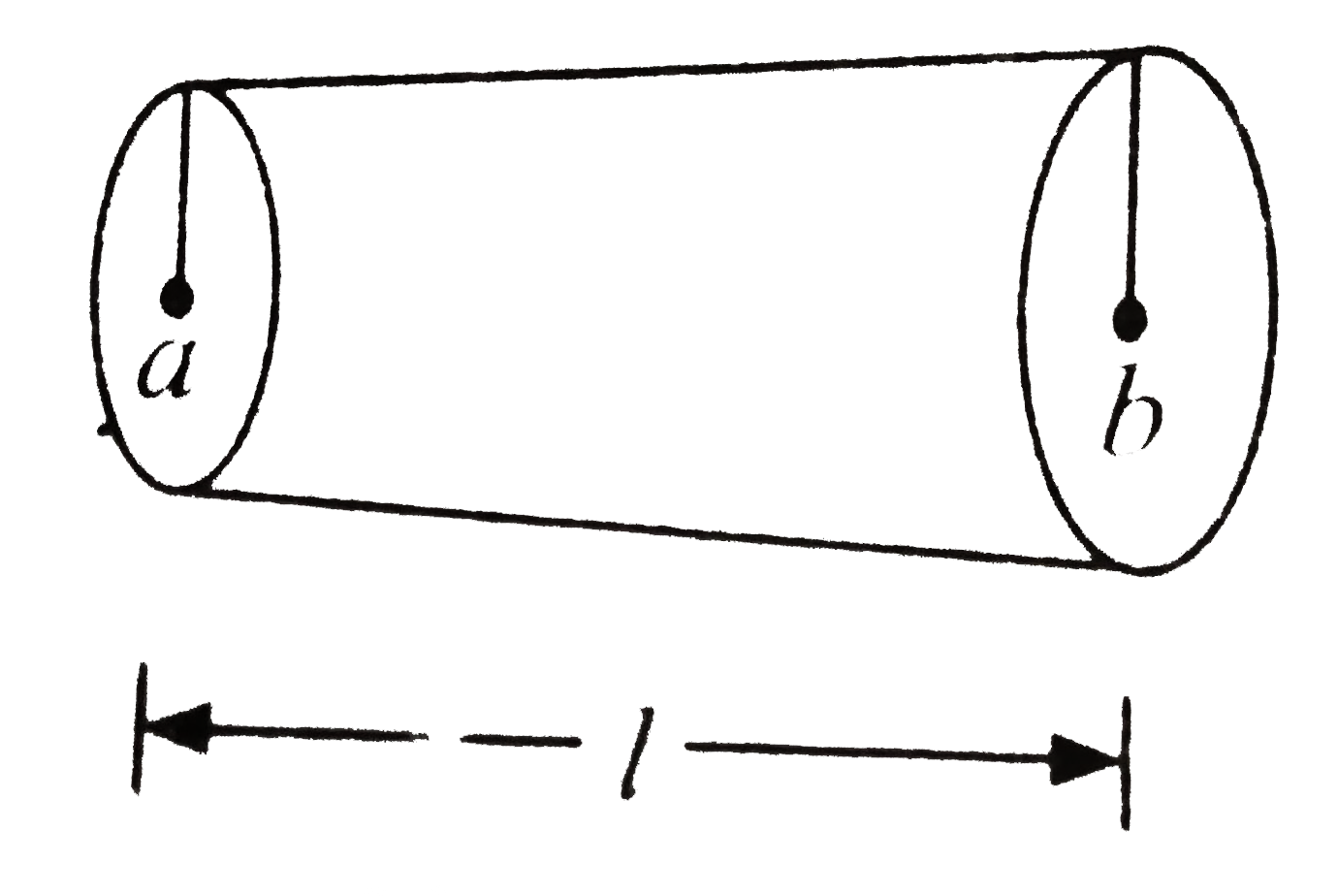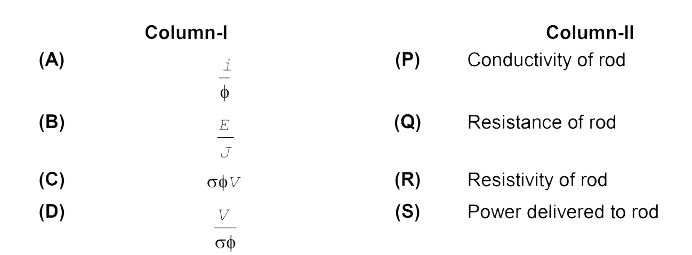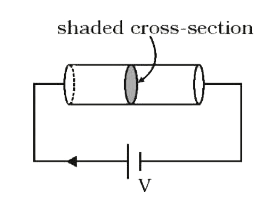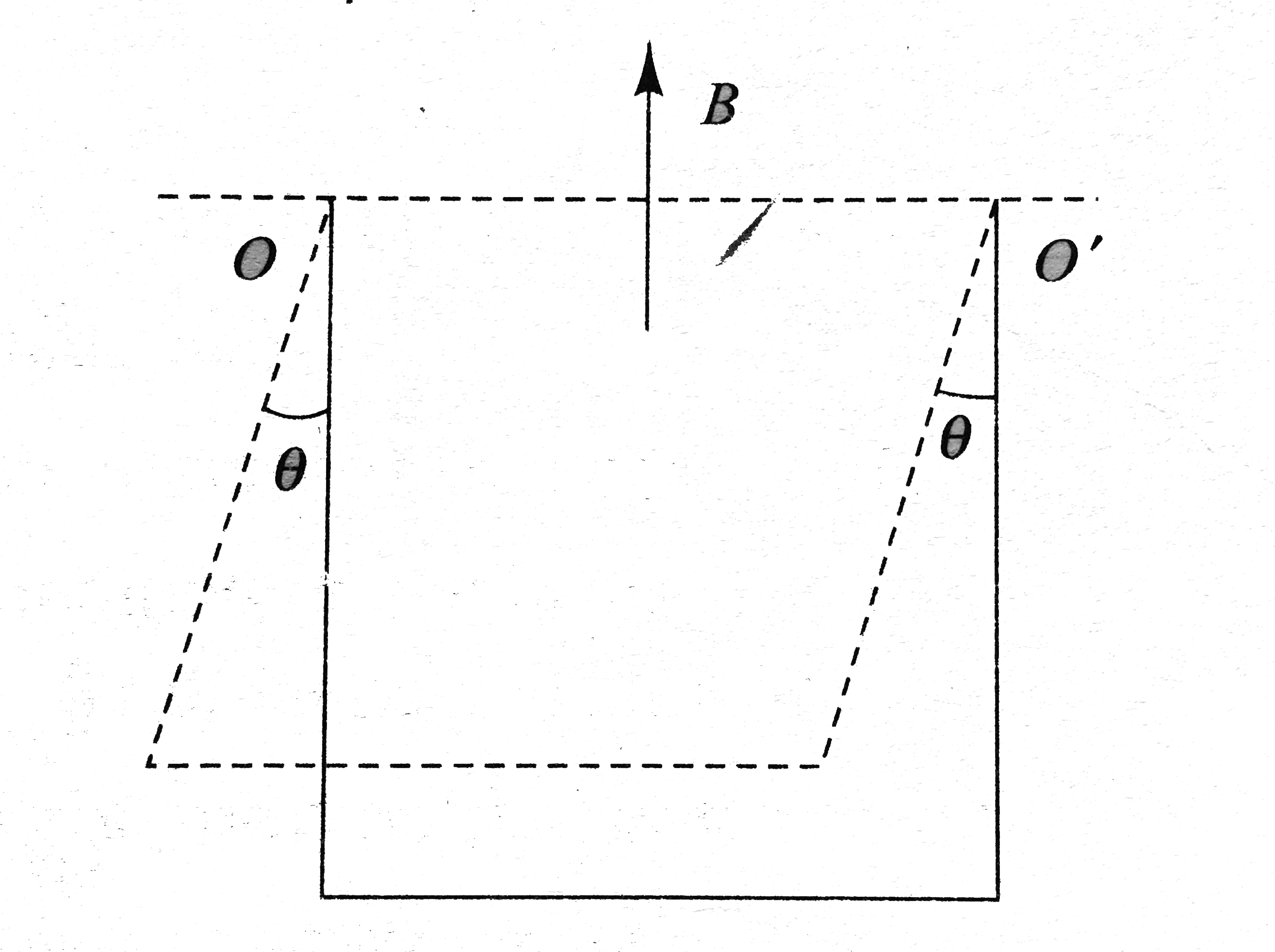A wire whose cross-sectional area is increasing linearly from its one end to the other, is connected across a battery of V volts. Which of the following quantities remains constant in the wire ?
(a) drift speed , (b) current density
(c ) electric current , (d) electric field.
Justify your answer.
(i) Consider an electron of mass m and charge e moving inside a conductor with a drift velocity Vd when an electric field E is applied.
Force on electron = eE. ma is the mechanical force the electron.
∴ma=eE==⇒a=eEmNowv=u+atHereu=0a=eEmt=τ( relaxation time)∴ud=eEmτ
Ohm's law :
∴I=neAvd∴I=neAeEmτ∴I=ne2AVmlτ∴R=VI⇒mlA ne2τ∴V=ml ne2AτI∴V∝I
Here Resistance R=ml ne2Aτ. ltbgt (ii) Current density remains constant in the wire whose cross sectional area is increasing linearly from its one end to the other as ,
Current density J=IA,
It is current per unit area, i.e, doesn't depend on area of cross sectional .
Drift speed vd=1Ane Electric field =J/A, is electrical conductivity.
Topper's Solved these Questions
- BOOK - XII BOARD PREVIOUS YEAR PAPER ENGLISHCHAPTER - XII BOARDSEXERCISE - SET-II DELHI BOARD (SEC-B)2videos
XII BOARDS
- BOOK - XII BOARD PREVIOUS YEAR PAPER ENGLISHCHAPTER - XII BOARDSEXERCISE - SET-II DELHI BOARD (SEC-C)4videos
XII BOARDS
- BOOK - XII BOARD PREVIOUS YEAR PAPER ENGLISHCHAPTER - XII BOARDSEXERCISE - SET-I (SECTION-D)1videos
XII BOARDS
- BOOK - XII BOARD PREVIOUS YEAR PAPER ENGLISHCHAPTER - SAMPLE PAPER 2019EXERCISE - SECTION D6videos
SAMPLE PAPER 2019
Similar Questions
A copper wire of radius 0.1mm and resistance 1k(Ω)is connected across a power supply of 20 V.(a)How many electrons are transferred per second between the supply and the wire at one end?(b) Write down the current density in the wire.
View SolutionA conductor of resistivity ρ and resistance R, as shown in the figure, is connected across a battery of emf V. Its radius varies from a at left end to b at right end. The electric field at a point P at distance x from left end of it is
 View Solution
View SolutionA device 'X' is connected to an ac source V=V0sinωt. The variation of voltage, current and power in one cycle is shown in the following graph:

(a) Identify the device 'X'
(b) Which of the curves A,B and C represent the voltage , current and the power consumed in the circuit ? Justify your answer.
(c) How does its impedance wary with frequency of the source ?
(d) Obtain an expression for the current in the circuit and its phase relation with ac voltage.View SolutionThe magnitude of electric current is increasing in a wire at a constant rate in the direction from A to B. Will there be induced current in the conduting loop show in fig? What will be its direction?
 View Solution
View SolutionColumn-I gives physical quantities based on a situation in which an ideal cell of e.m.f. V is connected across a cylindrical rod of uniform cross-section area and conductivity (σ ) as shown in figure. E, J, ϕ and i are electric field, current density, electric flux and current through shaded cross-section respectively as shown in figure. Physical quantities in Column-II are equal to those in column I. Match the expression in Column-I with the statements in Column-II.

 View Solution
View SolutionConsider a long, straight wire of cross-sectional area A carrying a current i. Let there be n free electrons per unit volume. An observed places himself on a trolley moving in the direction opposite to the current with a moving in the direction opposite to the current with a speed (v= i/nAe) and separated from the wire by a distance r. The magnetic field seen by the observer is very nearly
View SolutionA : When a steady current flows through a conductor of non - uniform cross-section , the current density , electric field and drift velcoity do not remain constant.
R : For a constant current the current density electric field and drift velocity are inversely proportional to cross - sectional area.View SolutionStatement I: A wire of uniform cross-section and uniform resistivity is connected across an ideal cell. Now the length of the wire is doubled keeping volume of the wire constant. The drift velocity of electrons after stretching the wire becomes one-fouth of what it was before stretching the wire.
Statement II: If a wire (of uniform resistivity and uniform cross section) of length l0 is stretched to length nl0, then its resistance becomes n2 times of what it was before stretching the wire (the volume of wire is kept constant in stretching process). Further at constant potential difference, current is inversely proportional to resistance. Finally, drift velocity of free electron is directly proportional to current and inversely proportional to cross-sectional area of current carrying wire.View SolutionA copper wire has a square cross section of 6 mm on a side. The wire is 10 m long and carries a current of 3.6A. The density of free electrons id 8.5x1028/m3.Find the magnitude of (a) the current density in the wire , (b) the electric field in the wire. (c ) How much time is required for an electron to travel the length of the wire? (rh, electrical resistivity, is1.72×10−8Ωm.)
View SolutionA wire of cross-sectional area A forms three sides of a square and is free to rotate about axis OO'. If the structure is deflected by an angle θ from the vertical when current i is passed through it in a magnetic field B acting vertically upward and density of the wire is ρ, then the value of θ is given by
 View Solution
View Solution

